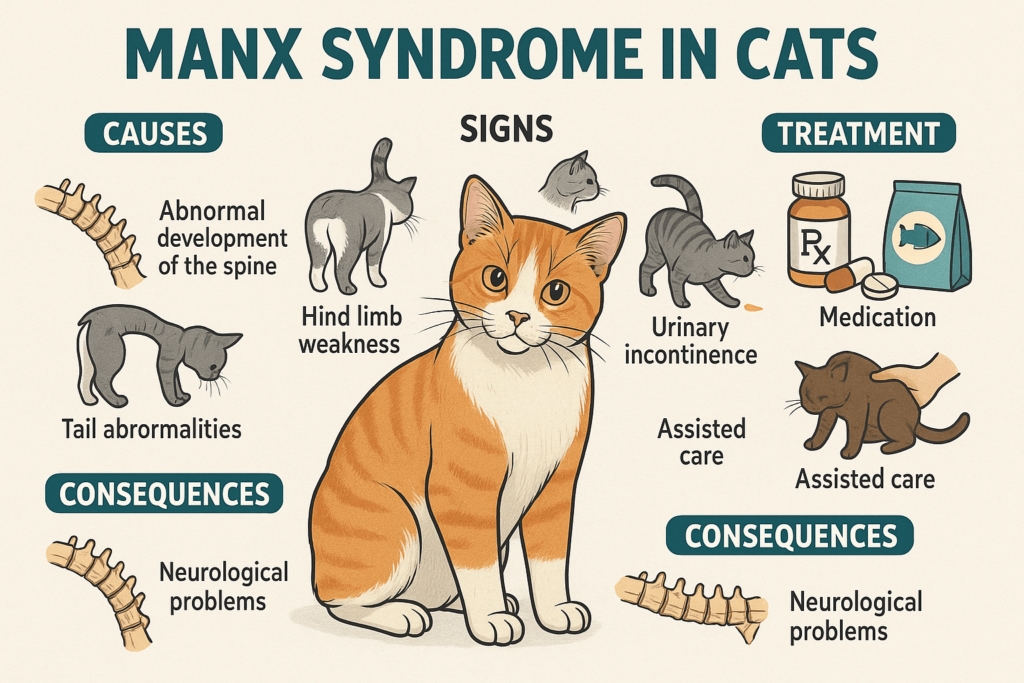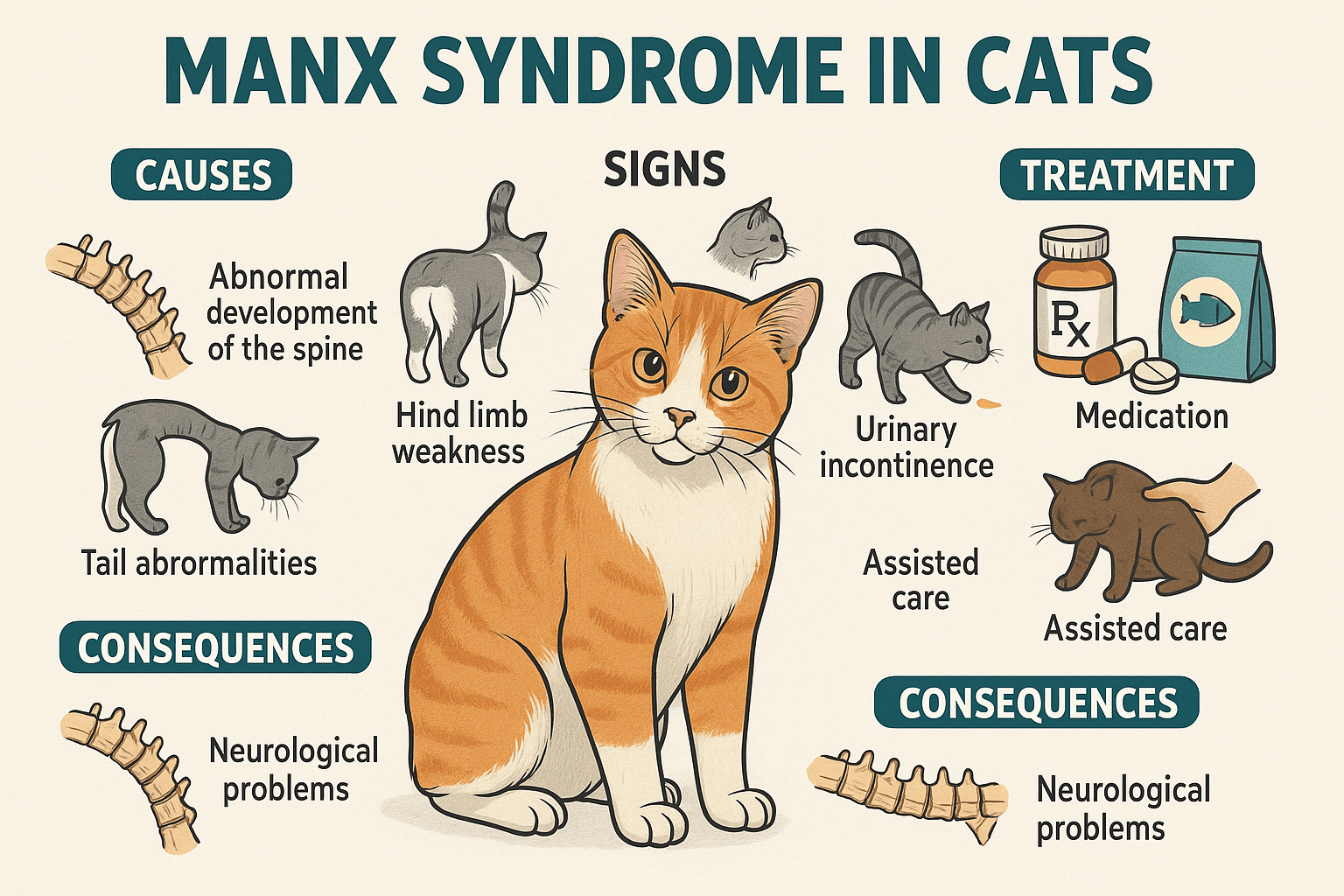Manx Syndrome in Cats: What Every Cat Owner Should Know
The Manx cat, known for its unique tailless appearance and playful personality, is a beloved breed among feline enthusiasts. However, beneath their charming exterior lies a potential health concern known as Manx syndrome. This condition, which affects the spine and nervous system, is a result of the genetic mutation responsible for the breed’s distinctive lack of a tail. Understanding Manx syndrome is crucial for anyone considering adopting or caring for a Manx cat. In this blog post, we’ll explore what Manx syndrome is, its symptoms, causes, and how to manage it effectively to ensure your feline friend lives a happy and healthy life.
Expert Opinion
Affected cats can have a slight wobble of the back legs and rump. They may have weakness in their rump and even develop hind limb paralysis in extreme cases. Sometimes these issues are severe. Manx kittens may die in utero or shortly after birth if affected. However, these abnormalities can be less severe and are more manageable.
What Is Manx Syndrome? Key Facts to Understand
Manx syndrome is a congenital condition that primarily affects Manx cats due to their unique genetic makeup. While not all Manx cats develop this syndrome, it’s important to recognize its characteristics and implications. Here are the key facts you need to know:
Spinal Abnormalities:
The mutation that causes taillessness can also lead to malformations in the spine, such as fused vertebrae or shortened spinal columns.Nerve Damage:
These spinal issues often result in nerve damage, which can affect mobility and bladder/bowel control.Genetic Basis:
Manx syndrome is directly linked to the dominant gene responsible for the breed’s taillessness, making it hereditary in nature.Variable Severity:
Symptoms can range from mild discomfort to severe paralysis, depending on the extent of the spinal abnormalities.Early Onset:
Signs of Manx syndrome typically appear within the first few months of a kitten’s life, making early detection critical.
Understanding these factors helps cat owners identify potential risks and seek timely veterinary care for affected cats.

Common Symptoms of Manx Syndrome
Recognizing the signs of Manx syndrome is essential for early intervention and proper management. If you notice any of these symptoms in your Manx cat, consult a veterinarian promptly.
Difficulty Walking or Hopping:
Affected cats may exhibit an unusual gait, hopping like rabbits instead of walking normally due to hind limb weakness.Incontinence Issues:
Loss of bladder or bowel control is a common symptom caused by nerve damage affecting pelvic functions.Chronic Pain:
Cats with Manx syndrome may display signs of discomfort, such as vocalizing more than usual or avoiding physical activity.Paralysis in Hind Legs:
Severe cases can lead to partial or complete paralysis of the rear limbs, significantly impacting mobility.Muscle Atrophy:
Over time, unused muscles in the hindquarters may weaken and shrink due to limited movement.
By staying vigilant and addressing these symptoms early, you can improve your cat’s quality of life and manage the condition effectively.
Check this guide 👉Cat Tail Signs: Best 7 Expert Tips!
Check this guide 👉Decoding the Mystery of Cat Tail Wagging: Best 7 Tips!
Check this guide 👉Cat Tapping Tail: Best 7 Expert Tips!
Causes of Manx Syndrome | Ways to Manage the Condition |
|---|---|
Genetic mutation causing taillessness | Provide a comfortable, low-stress environment |
Spinal malformations | Use padded bedding to reduce pressure sores |
Nerve compression or damage | Administer prescribed medications for pain relief |
Hereditary predisposition | Schedule regular vet check-ups for monitoring |
Early developmental abnormalities | Explore physical therapy options for mobility improvement |
How to Care for a Cat with Manx Syndrome
Caring for a cat with Manx syndrome requires patience, dedication, and a proactive approach to their well-being. Here are some actionable tips to help you provide the best care possible:
Create a Safe Environment:
Remove obstacles and hazards from your home to make navigation easier for your cat, especially if they struggle with mobility.Maintain Proper Hygiene:
Regularly clean your cat if they experience incontinence to prevent infections and skin irritation.Provide Nutritional Support:
Feed a balanced diet rich in nutrients to support muscle health and overall vitality.Engage in Gentle Play:
Encourage light exercise through play sessions tailored to your cat’s abilities to keep them active without overexertion.Work Closely with Your Vet:
Follow your veterinarian’s recommendations for treatments, therapies, and ongoing care to manage symptoms effectively.
With consistent care and attention, you can enhance your cat’s comfort and happiness despite the challenges posed by Manx syndrome.
Preventing Manx Syndrome Through Responsible Breeding
While Manx syndrome cannot always be prevented, responsible breeding practices can significantly reduce its occurrence. Breeders play a vital role in minimizing the risk of passing on harmful genetic traits.
Avoid Breeding Tailless Cats Together:
Pairing two tailless Manx cats increases the likelihood of producing kittens with severe spinal abnormalities.Screen for Health Issues:
Conduct thorough health screenings before breeding to identify potential risks in parent cats.Focus on Ethical Practices:
Prioritize the health and welfare of kittens over aesthetic traits like tail length when selecting breeding pairs.Educate New Owners:
Provide adopters with information about Manx syndrome and emphasize the importance of regular veterinary care.Promote Awareness:
Raise awareness within the breeding community about the ethical implications of perpetuating genetic disorders.
By adhering to these principles, breeders can help ensure healthier futures for Manx cats and their owners.
Additional Tips for Managing Mobility Issues
Mobility challenges are a common aspect of Manx syndrome, but there are ways to support your cat’s independence and comfort.
Use Assistive Devices:
Consider wheelchairs or harnesses designed for cats with hind limb paralysis to aid movement.Install Ramps or Steps:
Help your cat access favorite spots like couches or beds with ramps or pet stairs.Encourage Stretching Exercises:
Gently guide your cat through stretches to maintain flexibility and prevent stiffness.Monitor Weight Management:
Keep your cat at a healthy weight to avoid additional strain on their joints and spine.Offer Mental Stimulation:
Puzzle feeders and interactive toys engage your cat mentally, compensating for reduced physical activity.
Supporting mobility ensures your cat remains active and content despite their limitations.
Emotional Challenges Faced by Owners
Caring for a cat with Manx syndrome can be emotionally taxing, but acknowledging these challenges helps build resilience and compassion.
Dealing with Guilt:
Many owners feel guilty about their cat’s condition, even though it’s beyond their control. Focus on providing the best care possible instead.Managing Stress:
The demands of caregiving can be overwhelming. Practice self-care to recharge and stay positive.Seeking Support:
Connect with online communities or local groups for advice and encouragement from others in similar situations.Celebrating Small Wins:
Acknowledge progress, no matter how minor, to stay motivated and hopeful.Building a Bond:
Spend quality time with your cat to strengthen your relationship and find joy in their unique personality.
Embracing these strategies fosters emotional well-being for both you and your cat.
Alternative Therapies for Manx Cats
In addition to traditional veterinary care, alternative therapies can complement treatment plans for cats with Manx syndrome.
Physical Therapy:
Professional therapists use techniques like massage and hydrotherapy to improve strength and flexibility.Acupuncture:
This ancient practice may alleviate pain and promote healing by stimulating specific points on the body.Chiropractic Care:
Adjustments to the spine can potentially relieve nerve compression and enhance mobility.Supplements:
Omega-3 fatty acids and glucosamine support joint and spinal health, though always consult your vet first.Warm Compresses:
Applying gentle heat to sore areas can soothe discomfort and relax tense muscles.
Exploring these therapies offers holistic options to enhance your cat’s comfort and recovery journey.
Frequently Asked Questions About Manx Syndrome
Is Manx syndrome fatal?
While not always fatal, severe cases can significantly impact a cat’s quality of life. Early diagnosis and care are crucial.
Can Manx syndrome be cured?
Unfortunately, there is no cure, but symptoms can be managed with proper veterinary care and lifestyle adjustments.
Are all Manx cats affected by this syndrome?
No, not every Manx cat will develop Manx syndrome, but all are at risk due to their genetic makeup.
What should I do if my Manx kitten shows symptoms?
Contact your veterinarian immediately for a thorough evaluation and treatment plan.
Can Manx syndrome occur in other breeds?
It is rare but possible in breeds with similar genetic mutations affecting the spine.
Providing a Loving Home for a Manx Cat
While Manx syndrome presents unique challenges, it doesn’t diminish the joy and companionship that Manx cats bring to their families. With proper care, understanding, and commitment, you can create a nurturing environment where your feline friend thrives despite their condition. By staying informed, working closely with your veterinarian, and advocating for responsible breeding practices, you contribute to the well-being of not just your cat, but the entire Manx community. Remember, love and dedication go a long way in ensuring your tailless companion enjoys a fulfilling and happy life.
Canned Pumpkin for Cat Diarrhea: Best 7 Expert Tips! Natural remedy to firm stools, soothe upset bellies, and support gut health safely.
Can a Cat Give You Scabies? Best 7 Expert Tips! Discover the truth about feline mites, human skin risks, and how to protect yourself—without panic.
Cat Flea vs Human Flea: Best 7 Expert Tips! Discover the truth about bites, species, and how to eliminate infestations for good.
Weird Cat Behaviors: Best 7 Expert Tips! Discover why cats do strange things—and how to understand, not punish, their instincts for a happier home.





